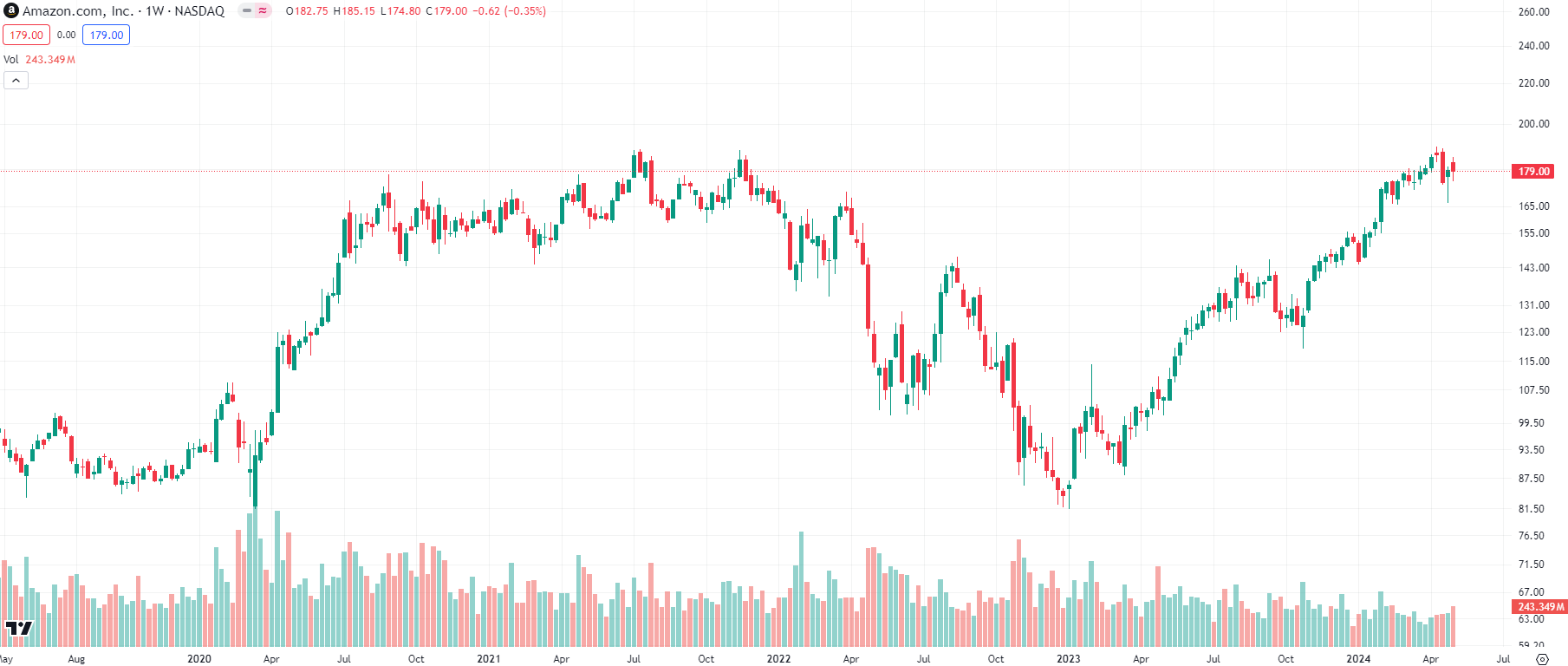Amazon (NDQ:AMZN) is a great company, but its not rising in 2024 for the reasons you might think
![]() Nick Sundich, May 7, 2024
Nick Sundich, May 7, 2024
Amazon (NDQ:AMZN) … the Everything Store. That was the title of journalist Brad Stone’s biography of the company as well as an accurate description of what the Magnificent Seven company does.
There’s little not to like about the company. The dominant market position in existing markets, the ability (the employee brains and capital) to go after new market opportunities and the loyalty of its customers. As Seattle’s Great White Shark approaches its 30th birthday, it isn’t necessarily the easiest time in its history. And yet, it has grown 72% in the last year, and its recent annual results were warmly received by investors. But not for the reasons you may think.

Amazon (NDQ:AMZN) share price chart, log scale (Source: TradingView)
Who is Amazon (NDQ:AMZN)?
The Everything Store essentially. It began as an online intermediary between book readers and wholesalers. Founder Jeff Bezos quit his job working for a New York hedge fund and moved across to Seattle to capitalise on the growth of the Internet.
As the years went on it expanded into more and more products and services, delivering them faster and faster to customers as well as expanding outside North America. We think two should be singled out.
First, its membership service Amazon Prime which boasts 200 million members around the world (a figure twice as high as 5 years ago). There is so much you get for it – expedited delivery (without delivery fees), Prime Video, Prime Music and exclusive access to deals (particularly on Amazon’s annual Prime Day).
Second is Amazon Web Services (AWS), offering Cloud computing services to individuals, companies and governments. This division began as just another idea in 2006, but demand for it exploded during the pandemic. With everyone working from home, you don’t want all your data just sitting on one computer somewhere that is only accessible in person. It now accounts for over $100bn on annualised revenue and over two-thirds of operating income.
Bezos recently stood down and was replaced by CEO Andy Jassy. He’s no newcomer, having been with the company since 1997 and playing a key role in the establishment of AWS.
A journey of growth (but not exclusively)
It has not always been easy for Amazon. The company survived the Dot com bust, yes, but it was a fight for profitability.
You could argue it wouldn’t have survived had existing retailers done anything at all to compete (other than tell themselves Amazon was just ‘1, 2, 3, 4, 5%…’) before it was too late.
Not all of its expansion efforts have been overnight success stories, or even successes at all. Its efforts to enter physical stores have generated some fruit (but with only US$20bn in revenue annually, they’re an afterthought in the context of the entire group).
Yet even as it reached profitability, margins have remained wafer-thin, leaving investors concerned amidst the Tech Wreck. However, these concerns have been cast aside by investors. In its recent quarterly report, it hit a double-digit operating margin, 10.7%. This was easily ahead of the previous high, 8.2% in the March quarter of 2021, and also up from 7.8% in the December quarter of 2023.
This was a result partly of better than expected revenue growth, including from AWS. But it was also from cost cutting. It cut 27,000 jobs since late 2022, it bought general and administration costs down by 10% and marketing from 5%.
What is it worth now?
Analysts covering Amazon have a target price of $215.35, a ~20% premium to the current share price. This is drawn from 56 analysts across Wall Street. We think Amazon is worth US$242.32 per share, using consensus estimates and an 8% WACC. Analysts expect US639.3bn in revenue and $4.40 EPS in CY24 (up 11% and 51% respectively), followed by $711.2bn in revenue and $5.54 EPS (up 11% and 25% respectively). For those wondering, US$1tn in revenue is a milestone expected to be reached in CY29.
How it compares to Walmart
Let’s turn our attention to Walmart, a company commonly compared to Amazon and arguably its best rival. After all Amazon’s founder who got richest from selling stuff in the 21st century, while Walmart founded by the man who got richest from selling stuff in the 20th century. Walmart lost Round 1 to Amazon, but it is not out of the game yet.
Walmart remains the world’s largest company by revenue and it is challenging Amazon in the eCommerce field. Its eCommerce sales are 13% of its sales and they have continued to grow over 10% post-pandemic even though many other eCommerce company revenues fell.
Walmart has several advantages over Amazon including its logistics and store networks, its cash reserves, the fact that it is a ‘one stop shop’ as well as the mix of goods, both essentials that are purchased regularly and bigger ticket items purchased less frequently but are higher margin for the company.
Another way in which Walmart is competing with Amazon is with its Walmart+ membership program. For US$98 per annum (or $13 monthly), you get benefits including free delivery, early access to Black Friday sales, fuel savings and a Paramount+ Essential Plan. Yet another innovation Walmart is working on is having EV chargers at its stores. It already has 1,300 fast-charging stations and plans to keep expanding the network.
At the same time, the one thing Amazon has that Walmart doesn’t is AWS and that will be a key driver of growth going forward. It is easy to overlook that Amazon uses AWS for its own purposes, and that is very convenient for it. Obviously the revenue comes in from companies that opt to use it, but the operational advantage cannot be overlooked.
Walmart’s most recent results impressed investors, although these were skewed by the Christmas period. The company is expecting 4-5% growth in FY24 and 3-4% in FY25. Amazon meanwhile is expecting over 10% sales growth and a profit that is expected to increase substantially. We may even see it pay its inaugural dividend – just look at Google and how its share price was boosted when it revealed it would pay out a share of its profit for the first time.
Conclusion
Amazon is one of the best companies out there and has a bright future ahead of it. However, those who think it is the growth of eCommerce aren’t looking hard enough at the company. The catalyst for growth is its profitability, that is only expected to get bigger, and growth from AWS that shows no signs of slowing down.
What are the Best ASX Stocks to invest in right now?
Check our buy/sell tips
Blog Categories
Get Our Top 5 ASX Stocks for FY25
Recent Posts
Your invitation to the Freelancer Investor Day
Your invitation to the Freelancer Investor Day Freelancer (ASX: FLN) is a Sydney-based company that has been the subject of…
Kamala Harris stocks: If Joe Biden’s VP wins the White House in 2024, which stocks will win?
With the US Presidential election now certain to be a Kamala Harris v Donald Trump showdown, we’ve looked at so-called…
South32 (ASX:S32): Is it the dark horse amongst ASX 200 miners or have cyclones and commodity prices hit it too hard?
South32 (ASX:S32) began life as a spinoff from BHP back in 2015, capitalised at $9bn. In mid-2024, it is capped…



